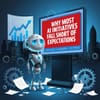Companies worldwide are pouring billions into artificial intelligence, yet a striking gap separates investment from real‑world payoff. Recent surveys reveal that roughly 95 percent of data leaders admit they lack full visibility into how AI makes decisions, and a similar proportion of generative‑AI pilots generate no measurable business impact. The root cause isn’t a flaw in the models themselves but a fundamental “learning gap”: enterprises often deploy AI as static tools that don’t adapt, retain feedback, or integrate smoothly into existing workflows, turning promising projects into isolated science experiments .
This disconnect shows up as a cascade of operational hurdles. Data leaders report that errors and hallucinations already disrupt business processes, and many teams stall deployments because they can’t explain AI outcomes or trust the results. When AI systems fail to improve over time, users revert to manual methods, eroding the promised efficiency gains. In short, the technology works, but the surrounding processes, governance, and skill sets are not yet mature enough to sustain it .
A severe talent shortage compounds the problem. Over three‑quarters of organizations cite a lack of AI‑skilled personnel, especially in machine‑learning modeling, data engineering, and business‑use‑case understanding. Without a robust pipeline of expertise, companies struggle to build responsible AI frameworks, address bias, and keep pace with rapidly evolving regulations. This skills gap forces many firms to rely on external consultants, yet even that route is hampered by insufficient external expertise and high costs .
Turning the tide requires a shift from viewing AI as a plug‑and‑play upgrade to treating it as a strategic capability that demands continuous learning, strong governance, and workforce upskilling. Organizations that embed AI into daily workflows, prioritize explainability, and invest in both internal talent development and external guidance are far more likely to see tangible returns. By closing the readiness gap—through better documentation, adaptive models, and a culture that values AI literacy—companies can move from hype to sustainable, value‑driven AI adoption .


